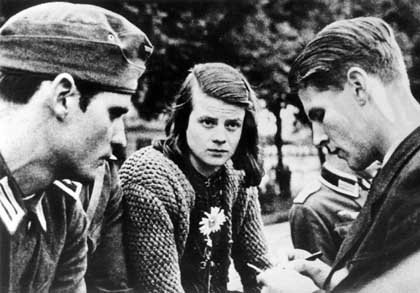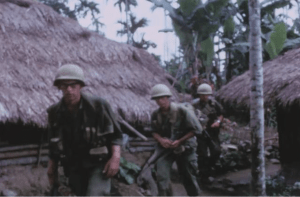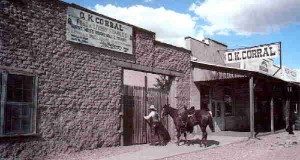Have you ever thought, why didn’t anyone try to stop Adolf Hitler? Were any Germans ever against him? Was the German community aware of the harm that Hitler was causing to innocent people? Indeed, there were. But who were the people behind these courageous acts? A group of college student attempted to stop Hitler and his heinous acts against Jews and his betrayal of the German people. In 1942, the group known as the White Rose arose in the streets of Munich, Germany. It was a student resistance movement that was created to expose Hitler to all of Germany. Their acts were believed to portray the true meaning of Christianity. The group made leaflets that contained information about the Nazis and their injustices. The letters were mailed to random addresses all over Germany. These students were willing to do whatever was needed in order to follow their moral duty and stop Hitler and his army.1
Sophie Scholl will always be remembered as one of the key individuals in the White Rose movement. She was born in Forchtenberg, Germany in 1921. She grew up in a religious and very political home. Her father was the mayor of the small town and her mother was a deaconess at their local church.2 Her parents raised her family to live an anti-Nazi life. Sophie was the second of three children. Both Hans and Sophie, like most other young Germans, were a part of the Hitler youth movement. There, individuals would be taught Nazi morals and train for battle. While in the program, Sophie and Hans were exposed to the injustices that were done by the Nazi government.3 Hans, her older brother, and his friends were responsible for starting the resistance movement. They named it after a white rose because it portrayed “purity and innocence.”4

Hans was attending the University of Munich when he started the movement. Along with friends that were also opposed to Hitler and the Nazi regime, they began writing leaflets that denounced the inhumanity of Hitler and his army. They described the Nazis as gangsters and violent criminals.5 After Sophie graduated High School, she followed her brother’s footsteps and attended the University of Munich, where she studied biology and philosophy.6
Sophie was an excellent writer, which played a crucial role in not only writing leaflets but distributing them as well. Not only did the group write leaflets, they spread their beliefs by spraying quotes on twenty-nine different public buildings. Some of the sayings were, “Down with Hitler” and the word “Freedom” on the sides of the entrance of the University of Munich.7 On one very significant leaflet, they exposed the horrendous acts, in which Hitler was responsible for the mass-murder of Jewish people. The group described this as, “the most terrible crime against human dignity, a crime not to be compared to any similar one in the history of mankind.” 8

One night, Sophie had a dream that she and her brother were arrested by the Gestapo. Little did she know that her dream would one day become a reality.
“Our people stand ready to rebel against the national socialist enslavement of Europe in a fervent breakthrough of freedom and honor.” This was the last line of the last leaflet that Hans and his sister would distribute on February 18, 1943.9 While everyone was in class, Hans and Sophie distributed the leaflets around the University. When they were done, Sophie went back and threw a stack of leaflets down a balcony. She was not able to flee the scene fast enough, as a Janitor saw her throw the leaflets down a balcony and went after her and the man beside her, Hans. The janitor stopped the individuals and reported the incident. Later, they were detained and taken to Gestapo Headquarters, where they were questioned. At the time, Hans still had a hand-written letter in his pocket, which incriminated his friend, Christoph Probst. The letter was potentially going to be the group’s next leaflet. Christoph was brought in for questioning. The individuals were detained for four days. They were questioned, and they in turn became victims of the brutality of the Nazi machine. While detained, the Gestapo broke one of Sophie’s legs. The three individuals were found guilty of “high treason,” and four days later were beheaded. The Gestapo did not stop, and they were on the lookout for other people who were involved in the group. It was not until five months after their execution when more members were detained and punished. One of the individuals was a Professor who had helped the group write some of the leaflets; he was later executed as well.10
The members of the White Rose stood up for their beliefs and condemned the horror of the Nazis, including Sophie, who was willing to do whatever was needed to inform others and stop Hitler from committing injustices, even if it meant losing her life in the process of it. They exposed the Nazis to all of Germany and fought to stop Hitler. Sophie Scholl along with her friends will go down in history for their braveness and courage to stop the Nazi regime.
- Annette Dumbach and Jud Newborn, Sophie Scholl and the White Rose (Oxford: Oneworld Publications), 5. ↵
- Women in World History: A Biographical Encyclopedia, 2002, s.v. “Sophie Scholl,” by Anne Commire. ↵
- John M. Lewis, “Germany and the White Rose,” New Hampshire Bar Journal 53, No. 2 (2012): 56-57. ↵
- Russel Freedman, We Will Not Be Silent: The White Rose Student Movement That Defied Adolf Hitler (New York: Clarion Books, 7 ↵
- John M. Lewis, “Germany and the White Rose,” New Hampshire Bar Journal 53, No. 2 (2012): 56-57. ↵
- Russel Freedman, We Will Not Be Silent: The White Rose Student Movement That Defied Adolf Hitler (New York: Clarion Books, 24. ↵
- Simon Henderson, “The White Rose and the definition of ‘resistance: Simon Henderson explains the significance of Hans and Sophie Scholl in the history of Nazi Germany,” History Review No. 53 (2005): 42. ↵
- Simon Henderson, “The White Rose and the definition of ‘resistance: Simon Henderson explains the significance of Hans and Sophie Scholl in the history of Nazi Germany,” History Review No. 53 (2005): 42. ↵
- Simon Henderson, “The White Rose and the definition of ‘resistance: Simon Henderson explains the significance of Hans and Sophie Scholl in the history of Nazi Germany,” History Review No. 53 (2005): 42. ↵
- Simon Henderson, “The White Rose and the definition of ‘resistance: Simon Henderson explains the significance of Hans and Sophie Scholl in the history of Nazi Germany,” History Review No. 53 (2005): 42. ↵



67 comments
Melyna Martinez
This article is so interesting to see even with the danger the movement brought how a group of young people still decided to stand up for what they believed was right. Sophie and her brother as well as their friends saw the rigor in movement and that an outcome for them may be death and yet they still move forward with it.
Anna Steck
This was a very interesting article. I was not familiar with this group at all before the reading. It gives the reader an example of why people didn’t speak out or had to hide any disagreement with the government. Their descent did end in their death. Its tragic, but it speaks to one of the ways Hitler was able to control Germans during his rule.
Sydney Nieto
This article was very interesting as college students were able to stand up again Hitler, as many people stayed quiet. I was also interesting to learn why they used a white rose as their monument. Sophie and her brother were arrested and killed in the end, but I do wonder what would’ve happened if more people were able to stand up to Hitler.
Hailey Koch
I really loved your article and all the information you provided, you did a really great job. Sophie’s plan was to bring attention to the bad things that Hitler had done in his life. She had an amazing writing ability which allowed her to write great leaflets. Her brother was the one that first started the movement about Hitler and she would soon join that movement as well once she had graduated high school. That is when she started writing which would soon get up to the public.
Adelina Wueste
This was a great article! I had no idea that a group of college students were against Hitler and the Nazis. It’s interesting to learn that the students who later expressed their frustration and anger with the Nazi party, were once part of the Hitler youth movement. It’s interesting to see that many of those in the Hitler youth movement were exposed to the injustices that the Nazis caused/practiced, yet only a few were brave enough to go against the party. This story is inspiring, yet the ending is very sad. It’s unfortunate to learn that a group with good intentions were eventually killed for their beliefs.
Eugenio Gonzalez
It was sad to hear the ending of Sophie, Hans, and the others who tried to stop Hitler and the Nazis. Before reading this article, I had never asked myself if they were Germans that did not agree with Hitler’s policies and if they intended to stop him. The article does a great job of describing the beliefs of the White Rose Association and how they manifested their discontent with the actions of the Nazis and Hitler.
Vianne Beltran
Hi Brianda,
Your article was really thought-provoking. It showed how ordinary, everyday students like us are capable of enacting change. The actions of Sophie Scholl and her companions were truly brave. They all could have lived quiet lives within the Nazi system but instead they chose to risk their lives for their beliefs. The picture you included of the memorial to them was also beautiful. I’m glad they are being remembered.
Brissa Campos Toscano
Hi Brianda! Congratulations on your article. It was extremely engaging and interesting to read. Your writing style is inspiring and motivates the reader to read. The introduction with the question made me feel extremely interested in reading your whole article. This is a new piece of history that I did not know about and I would like to thank you for writing about it. Thank you for showing us, the readers, something new about WWII. I didn’t know anyone would try to resist to Hitler’s movement. This shows the social impact his measurements made in Germany.
Madison Goza
What a fascinating article! I never knew about the youth resistance movements during World War II. Sophie Scholl ad the White Rose were extraordinarily courageous in willing to risk to their lives in order to expose the evils of the Nazi machine to Germany. You explained the subject very clearly and concisely, and I greatly enjoyed your writing style. Very well-researched! Great job!
Mia Gonzales
Brianda, your writings on the White Rose Resistance Group were inspiring and moving. I feel that not enough of womens’ and youths’ role in World War II from an Axis Powers perspective is not highlighted enough. This article truly shows that youths’ role in political affairs does matter and displays the embodiment of what it means to stand up for your personal beliefs.